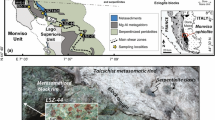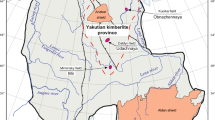Abstract
Oxygen and hydrogen stable isotope ratios of eclogite-facies metagabbros and metabasalts from the Cycladic archipelago (Greece) document the scale and timing of fluid–rock interaction in subducted oceanic crust. Close similarities are found between the isotopic compositions of the high-pressure rocks and their ocean-floor equivalents. High-pressure minerals in metagabbros have low δ18O values: garnet 2.6 to 5.9‰, glaucophane 4.3 to 7.1‰; omphacite 3.5 to 6.2‰. Precursor actinolite that was formed during the hydrothermal alteration of the oceanic crust by seawater analyses at 3.7 to 6.3‰. These compositions are in the range of the δ18O values of unaltered igneous oceanic crust and high-temperature hydrothermally altered oceanic crust. In contrast, high-pressure metabasalts are characterised by 18O-enriched isotopic compositions (garnet 9.2 to 11.5‰, glaucophane 10.6 to 12.5‰, omphacite 10.2 to 12.8‰), which are consistent with the precursor basalts having undergone low-temperature alteration by seawater. D/H ratios of glaucophane and actinolite are also consistent with alteration by seawater. Remarkably constant oxygen isotope fractionations, compatible with isotopic equilibrium, are observed among high-pressure minerals, with Δglaucophane−garnet = 1.37 ± 0.24‰ and Δomphacite−garnet = 0.72 ± 0.24‰. For the estimated metamorphic temperature of 500 °C, these fractionations yield coefficients in the equation Δ = A * 106/T 2 (in Kelvin) of Aglaucophane−garnet = 0.87 ± 0.15 and Aomphacite−garnet = 0.72 ± 0.24. A fractionation of Δglaucophane–actinolite = 0.94 ± 0.21‰ is measured in metagabbros, and indicates that isotopic equilibrium was established during the metamorphic reaction in which glaucophane formed at the expense of actinolite. The preservation of the isotopic compositions of gabbroic and basaltic oceanic crust and the equilibrium fractionations among minerals shows that high-pressure metamorphism occurred at low water/rock ratios. The isotopic equilibrium is only observed at hand-specimen scale, at an outcrop scale isotopic compositional differences occur among adjacent rocks. This heterogeneity reflects metre-scale compositional variations that developed during hydrothermal alteration by seawater and were subsequently inherited by the high-pressure metamorphic rocks.
Similar content being viewed by others
Author information
Authors and Affiliations
Additional information
Received: 4 January 1999 / Accepted: 7 July 1999
Rights and permissions
About this article
Cite this article
Putlitz, B., Matthews, A. & Valley, J. Oxygen and hydrogen isotope study of high-pressure metagabbros and metabasalts (Cyclades, Greece): implications for the subduction of oceanic crust. Contrib Mineral Petrol 138, 114–126 (2000). https://doi.org/10.1007/s004100050012
Issue Date:
DOI: https://doi.org/10.1007/s004100050012




